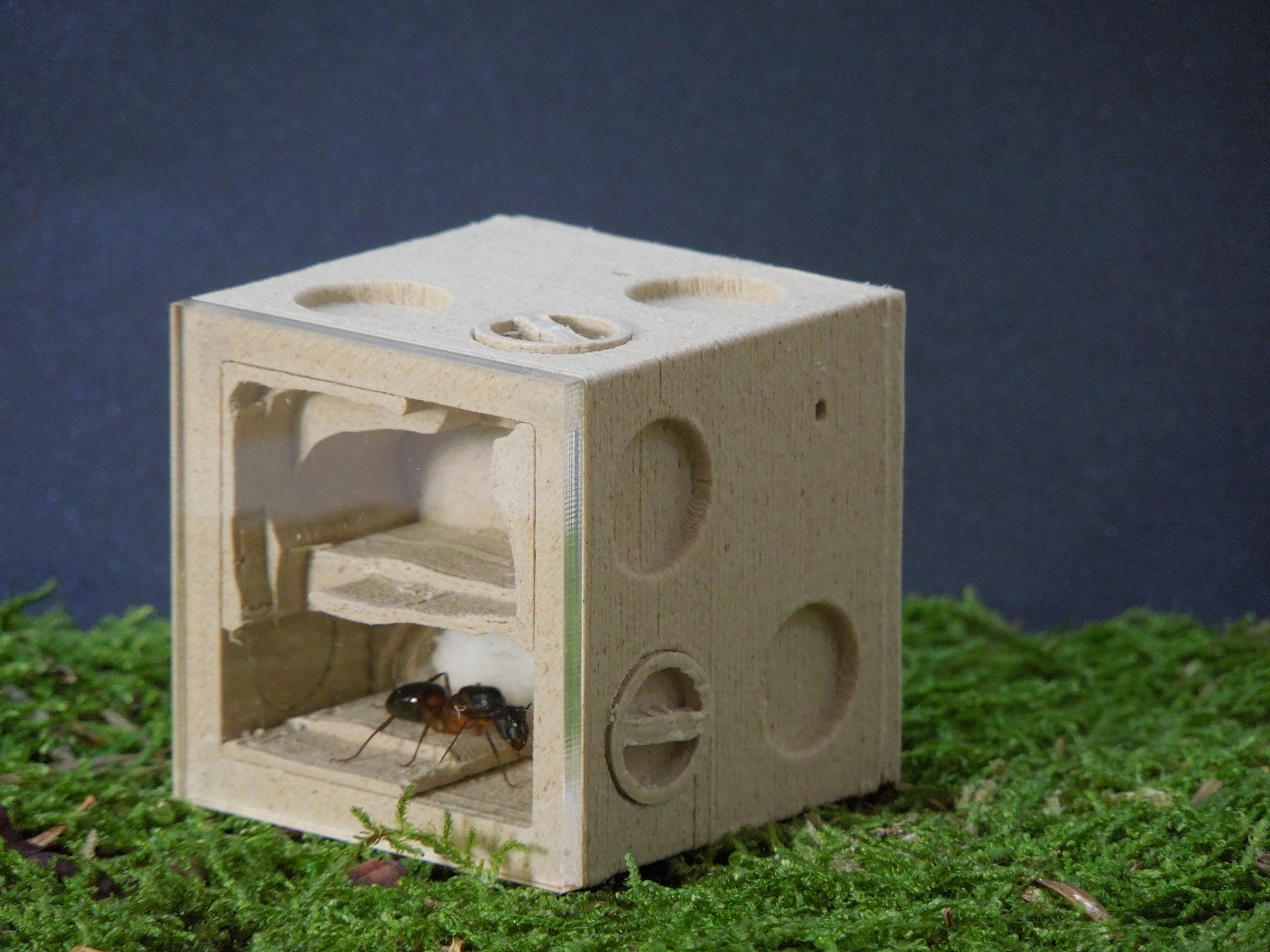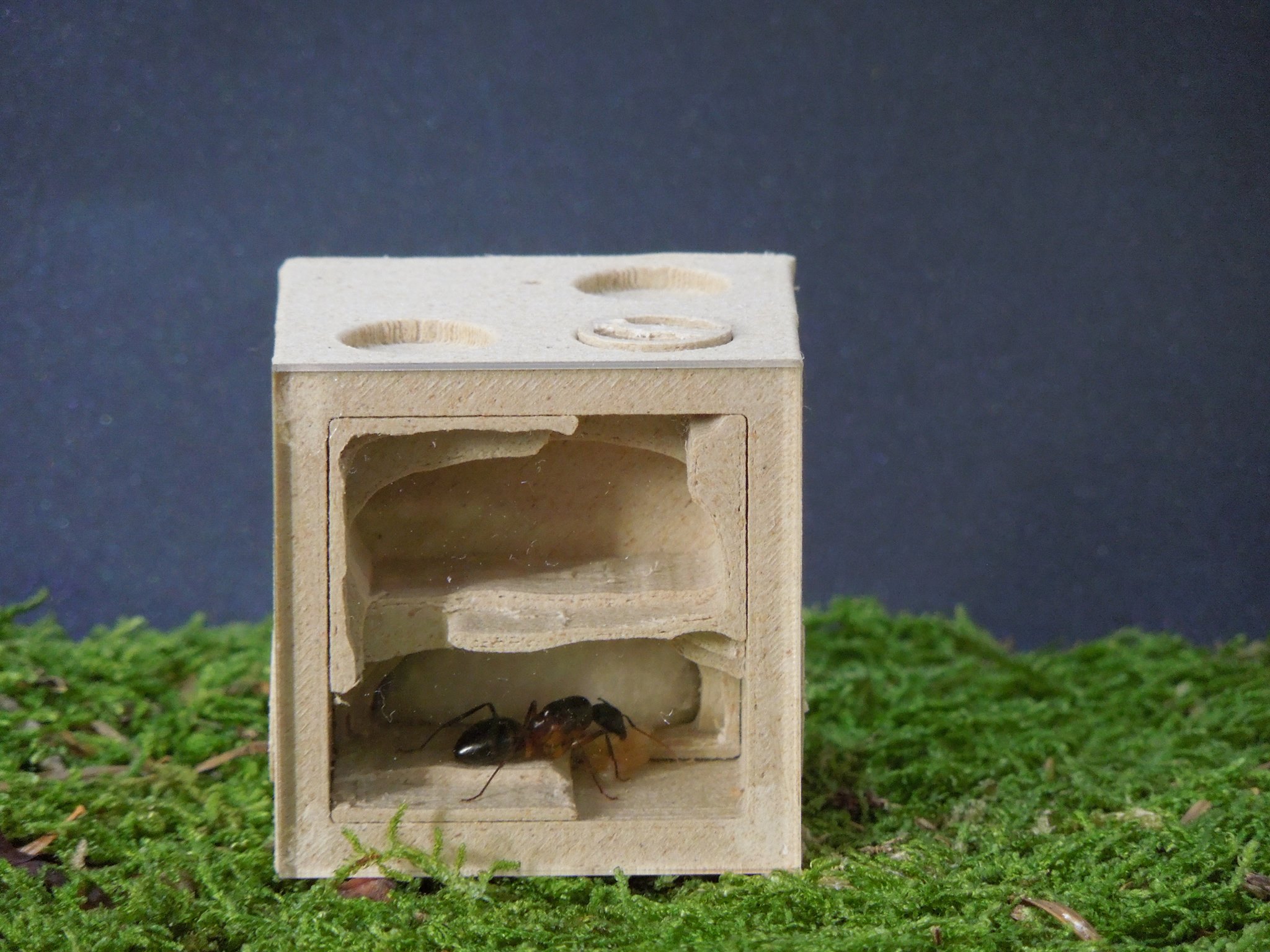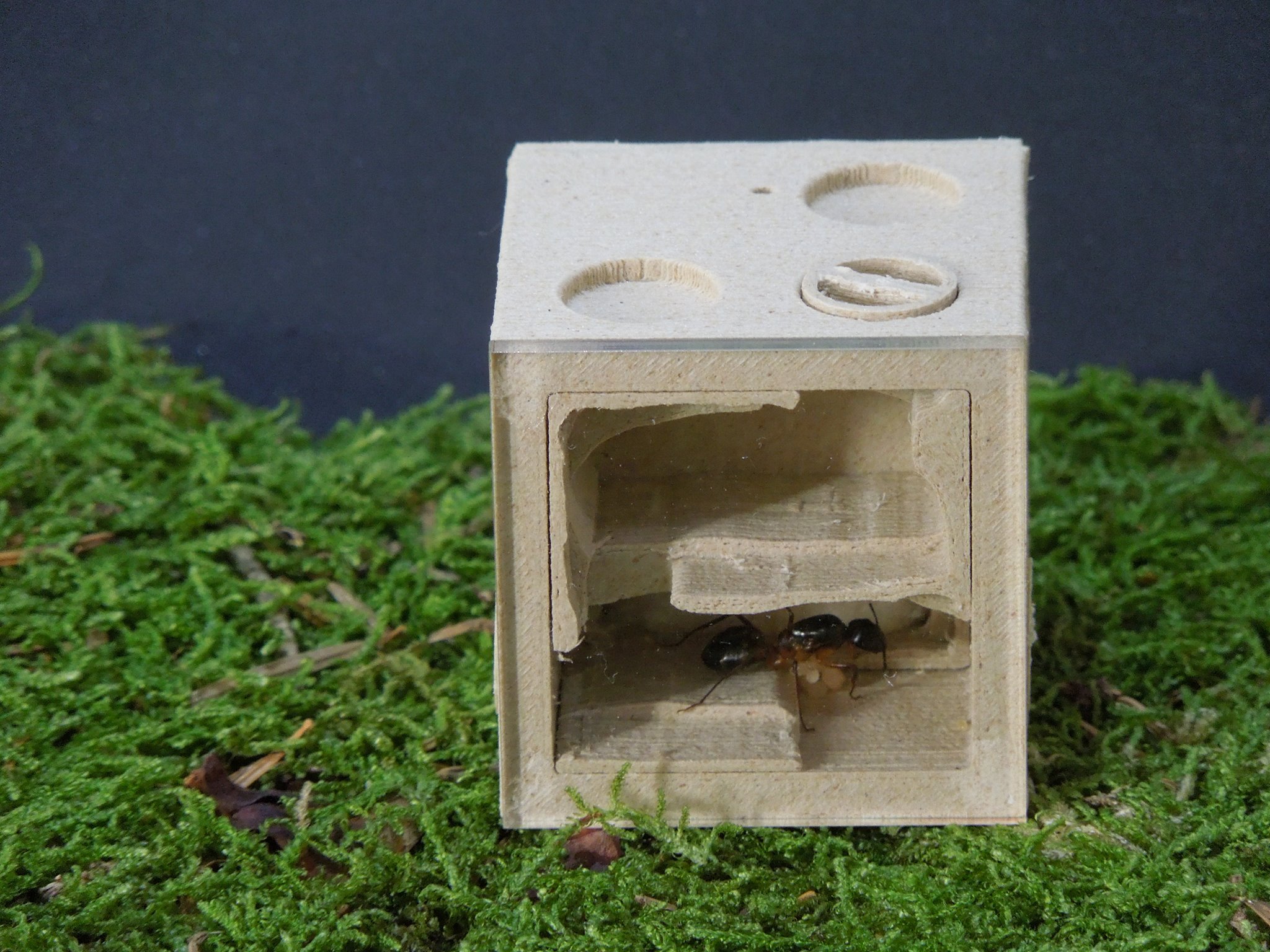PAN1c777 Modular Founding Formicarium
Review Purpose
The purpose of this review is not to criticize, diminish, lessen, embellish, promote or praise any brand, or products. The main concern is to provide ant keepers (novice and expert) our experiences while using commercial formicaria to facilitate their choice when considering which would be the most suitable for their actual, or future queens, and colonies.
Product description
PAN1C777’s modular claustros are small formicariums cubes made of 3d printing materials (ABS; PLA; and more recently wood fiber printing material).
26mm side cube – 26x26x26 [mm] – for queens smaller than 1 cm.
40mm side cube – 40x40x40 [mm] – for queens bigger than 1 cm.
LINK [ https://www.youtube.com/watch?v=1qMM0fhW0IM ]
For each different size there are two possible choices of cubes, an arena or a founding nest.
The arena has one front perspex window, one top door (20x16mm) for feeding or cleaning and three round connecting portals (one on each side and one on the bottom side).
The nest has one front perspex window, on the opposite side has one backdoor for inserting the different nest interchangeable layouts, humidity retainer material (cotton, etc), or cleaning. And also three round connecting portals ((one on each side and one on the top side).
Connection portals dimension is 10mm diameter.
Connection between nest and arena can be done in two ways depending on which option you choose. Connection option 1 – magnets connections
Connection option 2 – 3d print connectors (each module comes with one connector)
There are several options of nest interchangeable layouts available (at the time of the purchase there were three layouts available), one square 4 chamber layout; and two naturalistic chamber layouts (one chamber and two chambers).
Also each arena comes with two square dishes for placing honey/sugar water and food.
Product purpose, target audience, suitable species
Modular claustros are designed to provide queens with the right size where to found their nest.
Diverging from the market tendency on having horizontal/flat nests, PAN1C777 developed a side view nest. The way the nest is hydrated (from top and sides) provides new queens with a humidity gradient (since water is being pulled downwards by gravity) allowing them to choose the most suitable conditions for them. This matches the conditions offered in nature in most ants’ soil nests, where ants dig deeper of sideways depending on what conditions they are looking for (more or less humidity/temperature, etc).
Another interesting point on this design is the modular aspect; multiple claustros/arenas can be attached as the colony grows.
Easy maintenance and cleanliness, was an important factor as well. There is no need to relocate the colony if the cotton gets dirty or dry. Nests have three syringe openings to allow humidifying the cotton; also if cotton needs to be replaced, it is also possible.
They are suitable from novice to expert ant keepers. New product owners should nonetheless watch PAN1C777 Youtube’s videos about these modular claustros and get all the indications from PAN1C777 to become familiar with their different characteristics and options.
These Modular Claustros also appeal to a different target audience, for being small and inconspicuous they could easily pass for small decorations in some table until it reveals its true nature.
LINK [ https://www.youtube.com/channel/UCAX0vc0PIkBB2j5cniv71bg ]
They are advertised for different ant sizes depending on the type of claustro size chosen. Any species that would be kept in a test tube can be kept in the Modular Claustro.
26mm side cube – 26x26x26 [mm] – for queens smaller than 1 cm.
40mm side cube – 40x40x40 [mm] – for queens bigger than 1 cm up to 2 cm.
Price
Regarding the price, there are different options and multiple combinations.
40mm NEST:
- 40mm BASIC NEST £19 (White PLA)
- 40mm PLUS "INTERCHANGEABLE INTERIOR NEST" £21 (It comes with 1 Body + 1 Interior) (White PLA)
EXTRAS:
- "TRANSPARENT" ABS FILAMENT £1
- WOOD FILAMENT £2
- EXTRA INTERIOR White PLA £6
- EXTRA INTERIOR "Transparent" ABS £7
- EXTRA INTERIOR Wood £7.5
- MAGNETS £2
40mm BASIC ARENA (It comes with 2 mini dishes and 1 connection ring)
- 40mm BASIC ARENA £9 (White PLA)
- 40mm ARENA with MAGNETS £11 (White PLA)
EXTRAS
- "TRANSPARENT" ABS FILAMENT £1
- WOOD FILAMENT £2
- SKULL LOGO £2
26mm NEST
- 26mm BASIC NEST £9 (White PLA)
- 26mm PLUS "INTERCHANGEABLE INTERIOR NEST" £11 (It comes with 1 Body + 1 Interior) (White PLA)
EXTRAS
- "TRANSPARENT" ABS FILAMENT £0.50
- WOOD FILAMENT £1
- EXTRA INTERIOR White PLA £3
- EXTRA INTERIOR "Transparent" ABS £3.5
- EXTRA INTERIOR Wood £4
- MAGNETS £1.5 (Both for 26mm BASIC and PLUS NESTS)
26mm ARENA (It comes with 2 mini dishes and 1 connection ring)
- 26mm BASIC ARENA £5 (White PLA)
- 26mm ARENA with MAGNETS £6.5 (White PLA)
EXTRAS
- "TRANSPARENT" ABS FILAMENT £0.50
- WOOD FILAMENT £1
- SKULL LOGO £1
My experiences, my mistakes and my recommendations
I bought the following products:
2x - 40mm PLUS "INTERCHANGEABLE INTERIOR NEST" £21 (It comes with 1 Body + 1 Interior) (White PLA)
1x - 40mm ARENA with MAGNETS £11 (White PLA)
1x - 40mm BASIC ARENA £9 (White PLA)
2x - EXTRA INTERIOR White PLA £6
The species that I chose for the Modular Claustros were
Camponotus pilicornis - with one worker - naturalistic interior
Odontoponera denticulata - single queen - 4 squared interior
Both queens have proven difficult to rear in test tubes setups, and this would be a good test.
At the moment of writing it has been a month and half since the queen were introduced to their new setups. Both queens have laid eggs recently, which is a sign I always interpret as being very positive, also bearing in mind that they weren’t laying in a long long while.
Regarding Camponotus pilicornis, I think that this type of setup is great for them. It allows me to feed them without much disturbance. I can keep humidifying the nest regularly without any problems and the finally a setup where taking photographs is not a continuous problem due to strange reflections that come from round glass test tubes.
The queen always remains on the bottom level of the naturalistic interior (where the humidity is bigger), while the worker likes to stay on the top level. The worker will roam the arena, drink some sugary liquids from the dish and go back inside the feed the queen. At this stage there is not much more activity to report, but I am quite happy with the results so far.
As for Odontoponera, there was a longer period of adaptation to the Modular Claustro. This species climbing skills don’t match those of the Camponotus, and Odontoponera had some issues to reach the top level of the 4 squared interior. She has stationed on the bottom corner far side from the arena entrance, also where the humidity is bigger. She doesn’t forage often, but as soon as she smells new prey she will come out and collect it. She has layed 3 new eggs recently, and I am expecting her two larvae to pupate soon.
Some things I would like to point out:
Modular Claustro being 3d scan material built, end product does not maintain the exact dimensions as in the design (as one who is familiar with it would expect), and all pieces have a good and strong fit between them. This is very positive if you want to keep things closed. But you want to attach a new module, or do some change that involves opening a portal, etc, expect some disturbances in your colony, as the vibrations will be too big.
Some small printing imperfections might also be visible, but don’t affect in any way the formicarium performance.
I have both type of connection system between arena and nest, magnet and 3d print connector. For the easiness I would always go for magnet connections, but since the print is not 100% perfect, there might some possible gaps and escape routes if you are housing smaller species like Paratrechina, Solenopsis, Monomorium, Tetramorium, etc. For those I would clearly suggest using the extra snug fit 3d printed connectors.
From my Odontoponera experience, I have to say that I would avoid ants that don’t climb well. Some asian ponerinae are really bad climbers, and the transition from the bottom level to the top level isn’t easy for them. Of course keeping these ants is possible in this setup, just you wouldn’t be making the most of it, as I think they would avoid the top level of the nest. Possibly a better option for them would be the wooden fiber modular nest, I think it would allow better climbing surface for the ants.
Conclusion
I am really fond of this design and the versatility it offers. I think it's a type of formicarium you could easily bring to your office because it looks really clean and professional.
The feeling that these modular claustros give me is very soothing, the sideway view is great, and I can’t wait to have a reasonable size colony in them to appreciate the full potential of these claustros. Imagining how cool it would look to have multiple claustros for a single colony, just like building a LEGO, specially if PAN1C777 continues to develop and implement new designs into them.
Regarding the price, I think it is very accessible for what is it and who it is for.
I would recommend these for any ant keeper.











































